The Andromeda tomato, popular and beloved by summer residents: we grow it and enjoy a rich harvest
The Andromeda tomato is interesting for its colorful subspecies. After all, if all three varieties are planted in one area, you will get a real tomato flower garden! Ripe vegetables attract not only with their varied colors, but also with their excellent taste. Tomatoes are rich in vitamins and beta-carotene, which are necessary to maintain the health of each of us. Therefore, we invite all lovers of early ripening hybrids to get acquainted with a unique tomato from a Russian breeder.
Characteristics and description
The breeder of the f1 hybrid, Alexey Alekseevich Mashtakov, developed the culture in 1998. All his work was carried out in the Rostov region. Thanks to his merits, he is known not only in Russia, but also in neighboring countries.
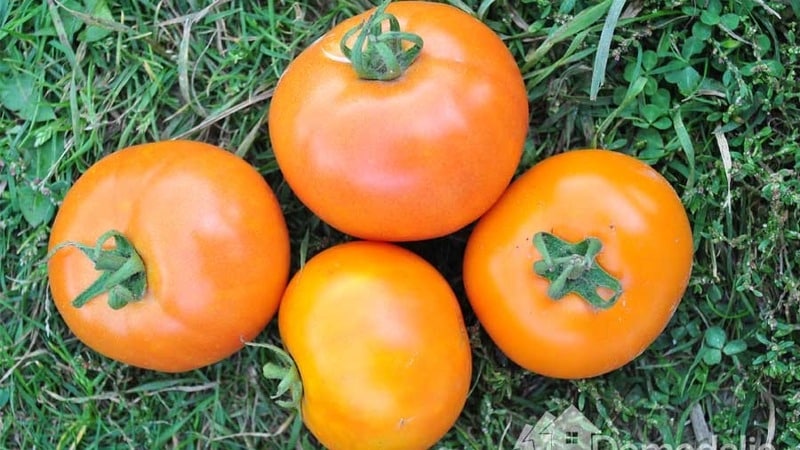
The hybrid has several subspecies: pink, gold, red. Outwardly, they are all similar: these are determinate, non-standard plants intended for open ground and greenhouses. The main difference between the subspecies is the color of ripe vegetables and their unequal weight.
Golden Andromeda has the largest fruits of the three subspecies, weighing up to 320 g. The pulp of ripe vegetables contains vitamin B, dietary fiber, lycopene and beta-carotene. This composition strengthens the immune system and suppresses depression. The taste of the fruit is sweet with a slight sourness.
The photo shows the tomato Golden Andromeda f1.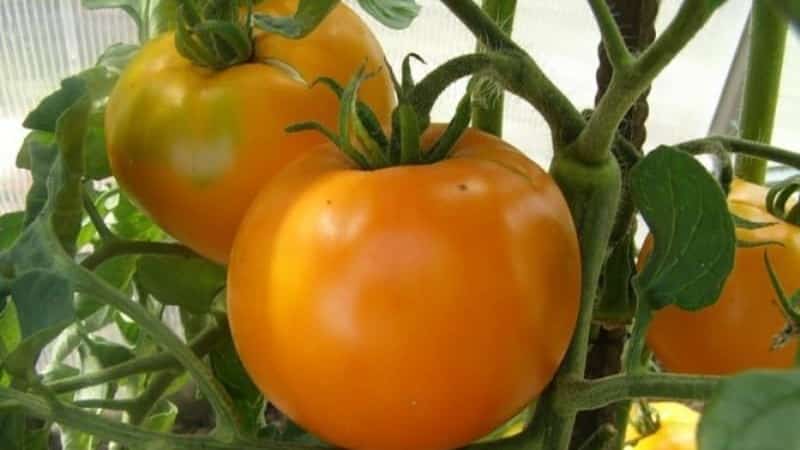
The weight of the Pink Andromeda f1 tomato fruit is 135-150 g, the appearance is attractive due to its soft crimson color.It is also interesting for its high fruiting rates: from 1 sq. m collect at least 8 kg. The taste is excellent, sweet. Ripe vegetables are stored for a long time and tolerate long-distance transportation well. This subspecies has the earliest ripening time - up to 90 days.
The photo shows Pink Andromeda tomatoes.
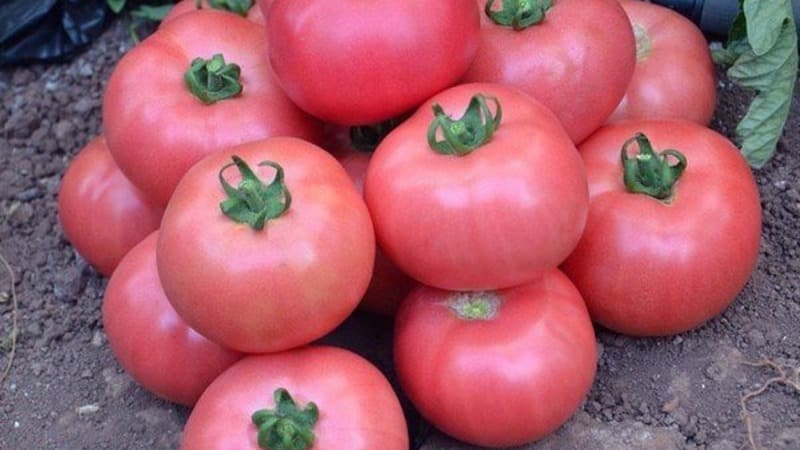
Distinctive features
Of the three varieties, the red subspecies is considered the main one.
The type is determinate, not standard, the height of the bush is up to 70 cm. The foliage is medium, the leaves are bright green, the branches are semi-spreading. The inflorescences are simple, the first inflorescence is formed above the 6th leaf, the subsequent ones - every 2 leaves. One brush bears 5-7 fruits.
The ripening period is early, from the moment of sowing to full ripening it takes 90-110 days.
Productivity is high, from 1 sq. m harvest up to 10 kg, provided that 4 seedlings are planted per 1 sq. m. m.
The variety is not highly resistant to diseases of the nightshade family; it often gets sick late blight.
Tomatoes are grown in open ground and greenhouse conditions. It can withstand low air temperatures very well.
The culture does not require mandatory stepsoning in the southern regions. In the northern regions, to avoid dense plantings, the plant is pruned, forming two stems.
Despite the short stature, gartering cannot be avoided, otherwise the fruit-bearing branches will spread along the ground under the weight of ripe fruits.
Fruit characteristics
The average weight of one fruit is 80-120 g. The shape is round, the color is bright red. The taste is excellent, sweet with barely noticeable sourness, the flesh is juicy, the peel is dense and does not crack. There are 4-5 seed chambers, a lot of seeds.
The tomato is universal in use: suitable for both fresh dishes and winter preparations. Used for wide production of pickles.Ripe vegetables are added to mousses, cocktails and pizzas.
Subject to long-term storage; vegetables can be stored in cool rooms for 4 months. Withstands long-distance transportation to any point.
How to grow seedlings
Sowing seeds for seedlings is carried out from March 1 to March 15. The final timing depends on the region and growing conditions. But do not forget that plants are transplanted into the ground at a soil temperature of at least 15°C.
Seed preparation
You won’t be able to prepare hybrid seeds yourself., since they do not retain parental properties in the next generation. Purchased seeds do not need to be disinfected; the hybrid manufacturer has already taken care of this.
The seed material is carefully inspected for visible defects and checked for emptiness. To do this, dissolve 1 teaspoon of salt in a glass of water and place the grains in it for 10 minutes. Those that have floated to the surface are not suitable for landing.
To improve germination, grains are soaked in a growth stimulator for 12 hours.
Reference. The most commonly used growth stimulants are Epin, Kornevin, Zircon.
In addition to specialized products, aloe juice is used as a stimulant. It not only improves germination, but also additionally disinfects against fungal infections.
Container and soil
The soil is prepared from garden soil, peat, humus and river sand in equal quantities. Having thoroughly mixed all the components, the soil is spilled with a hot solution of dark-colored potassium permanganate to destroy pathogenic flora. Harmful microorganisms are destroyed by steaming the soil in an oven at a temperature of 50°C for at least 10-15 minutes.
For sowing, use a common wooden box or individual containers: plastic cups, peat pots, paper honeycombs. Further care depends on the method of growing seedlings. With individual sowing it is reduced to a minimum.
Reference. When sowing in peat containers, transplanting seedlings is not required: they are planted in open ground along with the pot. It dissolves in the ground, feeding the root system with additional beneficial substances.
Sowing
Seed material is placed in planting containers to a depth of 1-2 cm, sprinkled with soil on top, leveled and covered with film or glass to create a greenhouse effect. The containers are left in a warm and bright room at a temperature of 22-24°C.
Periodically the film is removed for ventilation. The top layer of soil is moistened as it dries with warm, settled water using a spray bottle.
Further care of seedlings
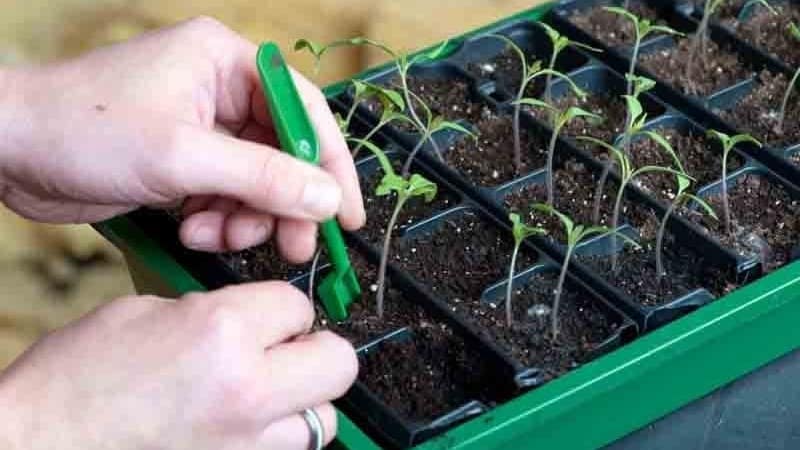
When the first shoots appear, the containers are moved to the windowsill to provide the seedlings with full daylight. If there is a lack of natural light, add phytolamps.
Water as needed with warm, settled water using a shallow watering can or tablespoon. After watering, the soil is loosened, creating conditions for better penetration of oxygen.
When 2 true leaves appear, the seedlings dive, planting them in separate containers. If the seedlings are left in a common container, increase the distance between the bushes to 15 cm.
Reference. The picking procedure allows you to select stronger plants for further development.
2-3 weeks before planting in the ground, seedlings begin to harden. To do this, it is taken outside in the daytime at a temperature of 16°C for 1 hour. Gradually this time is increased to 12 hours.At the same time, the night temperature is reduced to 13°C.
How to grow tomatoes
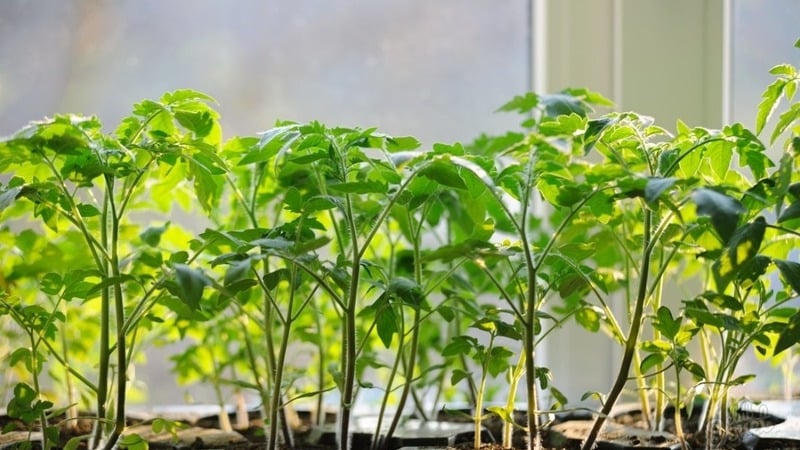
After 2 months, the seedlings are ready for planting in the ground. In terms of timing, this is mid-end of May. By this time, the bushes have 5-7 true leaves and fully formed young roots.
Landing
Planted in pre-prepared holes, to the bottom of which a little wood ash and mineral fertilizers are added.
Planting pattern: 40 cm – distance between seedlings, 65 cm – between rows. For 1 sq. m place no more than 4 plants.
After transplanting, the holes are watered with warm water, the soil is loosened and the seedlings are left to adapt to the new conditions for 1 week.
Advice. It is best to replant tomatoes in the morning or after sunset. This way, young plants quickly adapt to new conditions.
Care
Tomatoes are watered regularly, no more than 2 times a week. Tomatoes love moisture, so water them generously, at least 3 liters of water for each bush. But you can’t flood the beds: waterlogging can provoke the development of fungal infections.
After each watering, the soil is loosened and all weeds are removed. These simple procedures serve as a necessary preventive measure against pests.
Reference. Weeds are the favorite habitat of many parasitic insects.
The hybrid has a weak root system, so it needs feeding. Otherwise, it will not be able to provide all the ovaries with the necessary nutrients.
The first fertilizing is carried out during the formation of the first fruiting cluster. Feed with a full complex of mineral fertilizers or organic matter. For 1 sq. m use no more than 30 g of fertilizer. Iodine, yeast, wood ash or boric acid are used as organics. They are also fertilized with bird droppings or mullein infusion in a ratio of 1:15.Such feeding is carried out regularly, once every 2 weeks. Phosphorus and potassium are added to the mandatory fertilizing once a month to strengthen plant immunity.
Reference. It is not recommended to fertilize tomatoes with fresh manure, as they begin to intensively grow green mass.
Features of cultivation and possible difficulties
When growing plants in a greenhouse, it is necessary pinch And tie up. For gartering, wooden or metal supports are installed next to each bush, to which fruit-bearing branches are fixed as needed.
Form bushes with 2 stems. To do this, leave one stepson that grows under the first inflorescence. The remaining inflorescences are removed. If the greenhouse crop is not planted, the yield will decrease noticeably.
Diseases and pests
The hybrid is susceptible to late blight, but due to the early ripening period, the bushes often do not have time to become ill with it.
Late blight is a fungal disease that requires high humidity to develop. Therefore, it is important to control the level of humidity in the beds, avoiding overwatering. Closed structures are ventilated daily to avoid moisture stagnation.
In the fight against late blight, systemic fungicides are used, for example, Fitosporin. As a preventative measure in the spring, the soil is treated with copper sulfate, since fungal spores successfully overwinter in the soil and begin to develop in warm weather.
In open ground, tomatoes are susceptible to pest attacks.. The most dangerous of them are: the whitefly butterfly, the Colorado potato beetle, the mole cricket, aphids and slugs. The root system is protected from mole crickets by crushed cloves of garlic dug into the beds. Treating the stems with a soap solution helps against aphids and slugs.Tomatoes are protected from other insects by strongly smelling plants planted nearby.
Nuances for open ground and greenhouses
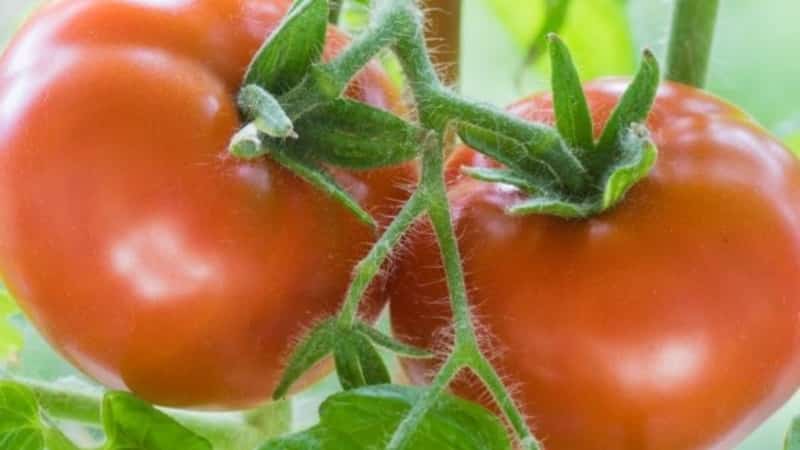
The hybrid is intended for breeding in the Central Black Earth Region and the North Caucasus. However, it has taken root well in cold regions in greenhouse conditions.
When grown in a greenhouse, the plant height reaches 1 m, which is significantly different from open ground.
In the southern regions, the variety does not require pinching; sufficient distance is left between the seedlings so that each bush receives the required amount of light. There is no dense planting in open ground. And in a greenhouse, plants must be pruned, otherwise thickening cannot be avoided, which will lead to the spread of diseases and pests.
In open beds, so that the fruit-bearing branches can support the weight of the fruit, additional supports are installed under them. The stem does not need a garter, although it is often fixed to a support installed next to the plant.
In rainy and cold weather, fruiting is delayed for 5-10 days.
Harvesting and application
The early-ripening hybrid produces a harvest 90 days after sowing the seeds. The ripening of the fruits is uniform, in whole clusters, which greatly simplifies the collection.
The use of vegetables is universal: they are used to make summer salads, hot and vegetable dishes, mousses, various snacks, pizzas, and freshly squeezed juice. Small tomatoes retain their flavor well in whole-fruit canning, marinades and pickles. Tomatoes go well with dill, horseradish, eggplant and meat. Ripe vegetables make delicious juices, lecho, adjika, and ketchup.
Ripe vegetables retain their presentation for 4 months if stored in a cool place.They can be transported over long distances to any location; the dense peel protects the vegetables from cracking.
Advantages and disadvantages
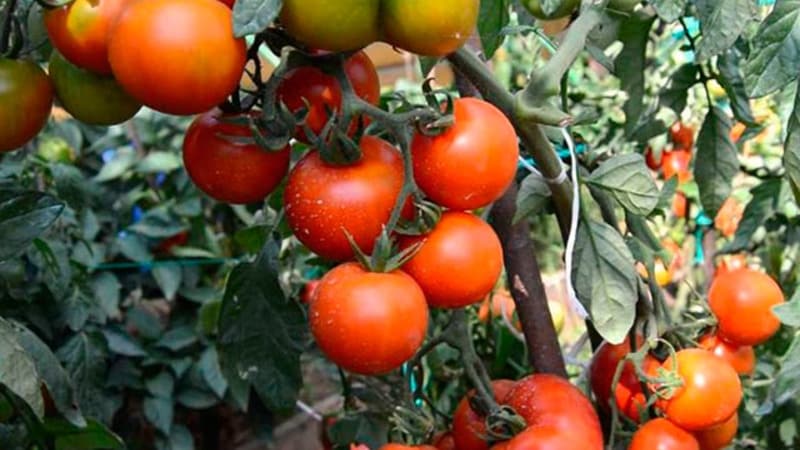
Advantages of the Andromeda hybrid:
- variety of species: pink, orange and red;
- cold resistance;
- good adaptation to any climatic conditions;
- simple agricultural technology;
- does not require pinching;
- high fruiting rate;
- excellent taste of vegetables;
- versatility in cooking;
- long transportation;
- preservation of presentation for a long time.
The negative aspects include:
- susceptibility to late blight;
- impossibility of independent selection of seed material.
Farmer reviews
The characteristics and reviews of the Andromeda tomato are almost exactly the same. Those who planted the hybrid note full compliance with the declared qualities. Here are the opinions of some gardeners:
Lyudmila, Rostov-on-Don: “Great view. I've been doing divorces for over five years now, and I've never let you down. I gave up on the others a long time ago, but I plant this one in a greenhouse and in open beds. Vegetables ripen immediately in whole bunches, so picking them is not difficult. The twists turn out to be the most delicious.”
Dmitry, Belgorod: “I plant the hybrid outdoors and in a greenhouse. Compared to other varieties, this one is much better. There was no late blight, but I treat it with Bordeaux mixture twice a season. I’m not particularly fussy about care, and the results are excellent.”
Conclusion
Tomato Andromeda f1 evokes an irresistible desire to make it your guest in the garden. The hybrid is unpretentious in care, high-yielding, cold-resistant, and takes root well in open ground and in greenhouse conditions. Several bushes will give a rich harvest even in cold areas with short summers.